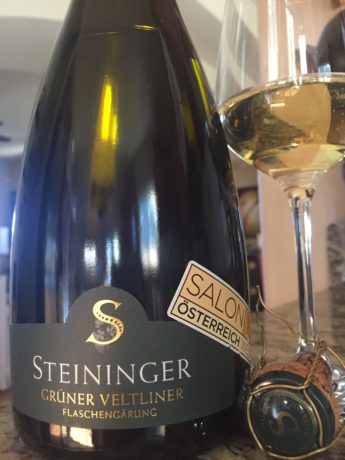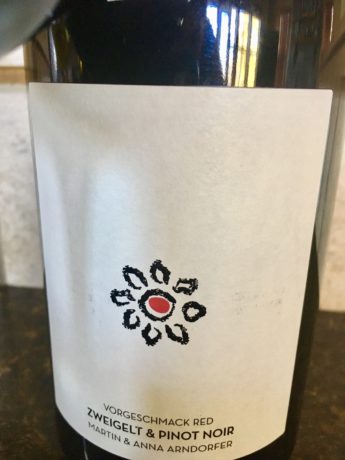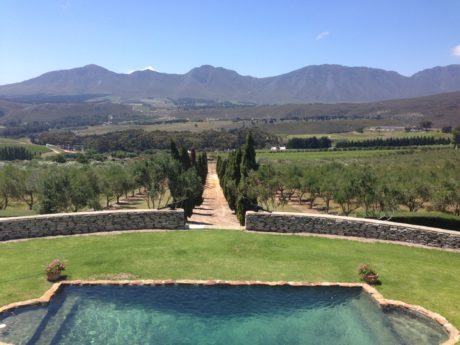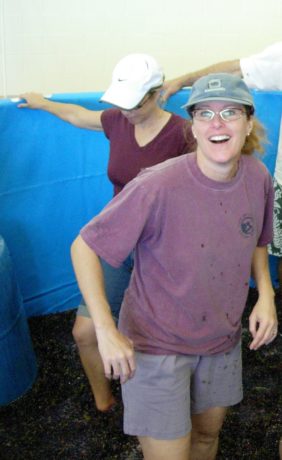Episode 135: Austrian Wine Regional Rap (Part 2)
Part 2 of our Austrian wine region rap we explore labels, laws, special designations, and bubbles. We just can’t get enough of Austria. Let’s talk about sekt, baybee!
In Our Glasses
Val:
Still sipping the Austrian Sekt, Steininger Grüner Veltliner, 2013, Flaschengärung, Niederösterreich, Austria. Because it was open, and it’s just as delish the next day.
Steph:
2014 Martin & Anna Arndorfer, Vorgeschmack Red, Niederosterreich. It’s 80% Zweigelt and 20% Pinot Noir. ($20.49)

Austrian Wine Region Rap (Part 2)
Last week we touched on geography, history, main grapes, and styles. While it wasn’t necessarily the deepest dive into the region, we wanted to provide a basic overview … without (hopefully) boring you guys to tears. Thank you to everyone who shared the episode profusely, and our excitement about Austrian wine!
In this episode, with our toes wet, we wade in a little further: we talk about the wine laws,, special designations, and sparkling wines (sekt).
The Labels and the Laws
The wine laws of Austria are similar to those of Germany with respect to ripeness levels. It makes sense to start here because we often have a tendency to compare them to the wines and laws of Germany. Yet, there are differences.
One of the main differences has to do with quality pyramid. The “top” level, Prädikatswein, on the German wine quality pyramid contains wines with the terms Kabinett, Spatlase, Auslese, Beerenauslese (BA), and Trockenbeerenausle (TBA) on the labels. These terms are based on ripeness levels of the grapes at harvest, and there are minimum must weight requirements for each style.
However, the Austrians do not include Kabinett in the Prädikatswein quality tier. They do have other styles the German Prädikatswein tier does not. Thusly, Spatlese, Auslese, Beerenauslese, Ausbruch, TBA and Strohwein are all categories of Austrian Prädikatswein.
But Wait – There’s More! Must Weight, Actually
The must weights are a little different than the German levels, and measured on a scale of KMW (Klosterneuburger Mostwaage) versus Oechsle. So, before we talk about the wines of the Ausbruch and Strohwein levels, you might be thinking, “Whoa – can you back up the must weight truck and fill us in on what a KMW is?” Absolutely.
Must weight is defined as one gram of sugar per 100 grams of grape must. The conversion for Austrian wines in degrees on the KMWs or Klosterneuberg Must Weight scale is 1 KMW = 1.2 degrees of what we know as Brix on the Baume’ scale, or 5 degrees on the German Oeschsle scale.
What About the Rust and Straw?
Back to the Ausbruch and Strohwein. Ausbruch is TBA level wine produced in the Free City of Rust. “Ausbruch” may only be used in connection with the geographical indication “Rust”. These wines are made from late harvested, botrytized, hand-picked grapes, and can be compared to Sauternes and the Hungarian Tokaj (Episode 56) in style.
Strohwein, or Schilfwein, is wine from fully ripened and sweet grapes that were dried for a minimum period of three months on straw mats, or hung up to dry, prior to any form of processing. The must weight must measure at least 25° KMW. The wines may not be submitted to the Prüfnummer tasting commission before 1 April in the year following the harvest.
The Deal with the DACs
Our desire to wander into this regional rap was inspired by the announcement in mid-October of a 10th DAC.
Here’s the quick and dirty. Districtus Austriae Controllatus (DAC) wines are unique in that they have production rules laid out and predetermined styles of quality wine that epitomize regional typicity. In other words, these rules are based on what grapes grow best in a specific region, and how the wine made from them best represents the terroir. These are all part of the Qualitätswein level of quality, just below Prädikatswein.
Most of the DACs have Klassik and Reserve styles, some have single vineyard designation. Each region has rules with respect to grapes, residual sugar, and minimum alcohol content required to carry the DAC designation on the label.
DACs for White Wines Only:
Weinviertal (2002) – Gruner Veltliner
Traisental (2006) – Gruner Veltliner and Riesling
Kremstal (2002) – Gruner Veltliner and Riesling
Kamptal (2008) – Gruner Veltliner and Riesling
DACs for Red and White Wines:
Leithaberg Red (2008) – Blaufrankish, St. Laurent, Zweigelt, Pinot Noir
Leithaberg White (2009) – Gruner Veltliner, Riesling, Pinot Blanc, Chardonnay, Neuberger
Red Only DACs:
Neusiedlersee (2011) – Zweigelt
Mittleburgenland (2005) – Blaufrankish
Eisenberg (2008 for Reserve, 2009 for Klassik) – Blaufrankish
Field blend:
Gemischter Satz (2013): This thing is its own animal.
We mentioned this one a few episodes back. (Ep131) The grapes must grow in a Viennese vineyard planted with at least three quality white varieties, and must be harvested and pressed together; the biggest portion of a single grape variety must be no more than 50%; the third largest portion must be at least 10%.
A DAC for Rose’ Wines Only:
And now there’s the Schilcherland DAC (2017) which is rose’ only and made from Blauer Wildbacher. This DAC is in Steiermark. Many of us think of schilcher as meaning a rose’ wine, but the term schilcher actually means everything from glitzy, iridescent, shimmering and glittering in German schillernd. So … pink bling wine? We’ll go with “yes, please!”
Other Classifications
Vinea Wachau
Wachau has their Vinea Wachau for dry wines from a specific growing area that is defined by law. It was created in 1983, although the name Vinea Wachau Nobilis Disctrictus has its roots in the 13th and 14th century and Leuthold I von Kuenring.
There are three styles unique to Vinea Wachau named after the local flora and fauna:
- Steinfeder – which means feather grass native to the region
- Federspiel – a bird otherwise known as a falcon treat (i.e. food for raptors)
- Smaragd – lizard that hangs out in the vines
The thing to remember about these wines is they increase in power, structure, and alcohol, becoming richer in style, with Smaragd being the most full-bodied.
Erste Lage
Winegrowers responsible for creating the Erste Lage association are growers from within the Kremstal, Kamptal, Traisental and Wagram. This dates back to 1990.
Erste Lage, or 1st growth vineyards, were established by the 23 panel members of Association of the Traditional Vineyards of Austria (Traditionsweingüter Österreich) In May 2010, after nearly 20 years of consideration, the 23 members of the panel of incorporated 52 vineyards. Their focus, obviously, is on vineyards and sites in addition to quality of wine, where the DAC rules are more focused on wines characteristic from places, yet they still support the DAC laws. Their philosophy is, “Everyone knows that you can make a great wine only out of a great vineyard.”
Sekt
Austrian bubbly doesn’t get much attention, but it has its own quality pyramid since 2015. The different levels determine whether the bubbly has to be produced via classic/traditional method or tank/Charmat, as well as qualified styles.
The “bottom” is Klassik – it can be produced with either tank or classic (or any other, such as transfer) method, and in any style or sweetness. It is only released after 22 October, the year following harvest. Vintages are permitted on the label, and no stated origin is required.
The next level up is Reserve. Classic production (bottle fermentation and aging) is mandatory, as are18 months time on lees. There is no blending of red and white grapes for Reserve level, and the wine can only be released after 22 October the second year after harvest.
At the top is Grand (Grosse) Reserve, which can only be made in brut nature, brut, and extra brut styles. Classic method and 30 months time on lees are mandatory, as is hand harvesting of grapes. This is the strictest category, and bottles cannot be released before 22 October the third year after harvest.
Other Sekt Fun Facts
- Robert Alwin Schlumberger was the first person to produce Sekt in Austria in 1842. He learned how to make Champagne from the cellar master at the oldest champagne house, Ruinart Père et Fils, where he eventually became production manager.
- Sekt styles are varied, from white, red, and rose and dry to sweet. Rose’ is becoming very popular, and the Schilcher Sekt is a specialty.
- Most of the sekt wines have traditionally come from the Weinviertel region bordering Czech Republic.
- There are 36 (22 white/14 red grapes, including Cabernet) approved grape varieties, but main grapes are Gruner, Pinot Blanc and Welschriesling.
- Minimum atmospheres of pressure in the bottle is 3.5.
- There are about 12 million bottles produced annually.
- 22 October is celebrated each year as “Sekt Day”.
Learn more…
If you’re looking for more information on Austrian wine, we cannot recommend http://www.austrianwine.com enough! Also, be sure to check out entries in:
Johnson, H., & Robinson, J. (2013). The world atlas of wine (Seventh ed.). London: Mitchell Beazely.
Robinson, J., & Harding, J. (2015). The Oxford companion to wine (Fourth ed). Oxford: Oxford University Press.
Robinson, J., Harding, J., & Voui amoz, J. (2012). Wine grapes: A complete guide to 1,368 vine varieties, including their origins and flavours. New York: Ecco.
Stevenson, T., & Avellan, E. (2014). Christie’s world encyclopedia of champagne & sparkling wine. New York: Sterling Epicure.
http://www.traditionsweingueter.at/en/
http://gruppe.schlumberger.at/
http://www.advantageaustria.org/
Wino Radar
Have you heard of Indie Wineries?
They are an import company that is now on Steph’s radar because she was drinking their wine on this show and enjoying the heck out of it! Their wines represent small producers all over the world in places like Croatia, Slovenia, Portugal, Austria and more. They are no joke, and have gotten some press in The Somm Journal and Huffington Post.
Reminders:
#W25BookClub
Our next book is a recommendation from Patron and friend Cathey Love in Tennessee. It is the autobiography A Glass Full of Miracles by Mike Grgich.
We love this suggestion Cathey posted on our Facebook community page because of two reasons: Mike’s daughter, Violet Grgich, was a guest on this podcast a year ago in Episode 79; and 2017 marks Grgich Hill’s 40th anniversary.
Also, with regard to the devastating California wildfires, Grgich Hills is safe and open for business.
Reminders:
- Please use the #W25BookClub on social media!
- You can easily order the book right here.
- The Book Review Episode will air on December 21st
Wine Blogger’s Conference in Santa Rose #WBC17
The Wine Two Five Podcast will be representin’ this year at the Wine Blogger’s Conference: https://winebloggersconference.org/about/ November 9-12, 2017 in Santa Rosa. Please come and say hi!
Shoutouts
Steph: “Hamilton-Russell Vineyards in South Africa is a new #W25Challenge for me. I was looking for Austrian bottles at Supermarket Liquors and my eyes ran upon a 2012 Pinot Noir from this estate in the Hemel-en-Aarde Valley appellation. My curiosity and intuition forced me to add it to my cart-o-wine. We opened it with friends and it was KILLER!!! ($40) This bottle nods to Burgundy and makes a classy gift. If you’re looking for a “statement” wine under $50, this is one!”
We talked a little more about this winery, as Val got to actually spend time here, and enjoyed an incredible meal with Anthony and Olive at their estate in the Hemel-en-Aarde Valley. Hemel-en-Aarde means “heaven on earth.” In addition to the generous hospitality and the gorgeous wines, well, this was our view from the back veranda of the Hamilton-Russell estate. 
If that’s not heaven on earth, we don’t know what is.
Also, shoutouts are in order for:
- Austrian Wine USA, thank you for the shoutout and share!
A nice overview introduction on #AustrianWine part 1 https://t.co/DArMupp3jb via @winetwofive
— Austrian Wine USA (@AustrianwineUSA) November 2, 2017
- Also, thank you to Andrea at ParMieux Wine Ventures in Istanbul for sharing the episode (and listing us in your blog favs)!
I love that people are talking about Austrian #wine now! You definitely need to listen to @WineTwoFive ! #wein #winelover #winelovers https://t.co/FirruyoYGg
— ParMieuxWineVentures (@LemieuxAndrea) November 2, 2017
Patreon Love
Thank you to our Patrons who support us on our Patreon crowdfunding platform.
“TENacious Tasters”
- Jeff E from the We Like Drinking podcast
- Lynn from Savor the Harvest blog
- Sebastian of Sassi Italy Tours
- Jen in Maryland (and the world, according to her Instagram feed)
- David and Lisa in Illinois
“It’s not five o’clock and we don’t care” Listeners
- Clay in Arizona
- Jon in California
- Andrew in California
- Aswani in California
- Chris and Janet in Colorado
- Diane in Colorado
- Cathie in Georgia
- Steve in Illinois
- Renee in Illinois
- Ashley in North Carolina
- Chantel in Ontario, Canada
- Mary Lou in Pennsylvania
- Meg in South Dakota
- Cathey in Tennessee
“Tastemaker” Listeners
- David in Scotland
- Carole in Kentucky
- Karen in California
A little more about Karen, our newest patron:

“So glad I FINALLY joined the elite group of Patreons. I listen to your podcast while hiking in the mountains of Santa Barbara or walking along the beach (such a tough place to live). I moved here 21 years ago and hoped to work in the wine business as I was always a wine geek; you know, one of those people no one wanted to play Wine Trivia with. Teaching, another love, got in the way of that dream. One day while sitting in a bar, I struck up conversation with the bartender and a couple other employees who encouraged me to take the Level One Somm test being given in two months. It was time to put up or shut up. I put up. That success led me to retire from elementary education and instead work for Zaca Mesa Winery in Santa Barbara County. I wanted to further my education, but the Somm route didn’t seem to fit. Instead, I got my CSW over a year ago. I only work part-time because my husband and I love to travel. Travel includes at least one of : golf, snorkeling, wine tasting. We just spent three weeks in Green Spain and the Douro in Portugal. I found out I actually do like Port, but the Port I like is over $150 a bottle, figures. I could go on-and-on, but it is time for a hike and another episode of Wine Two Five.”
“Winetastic” Listeners
- Laura
Go to our Patreon page for details www.patreon.com/winetwofivepodcast on how to be entered into our monthly drawing, exclusive content, and swag.
Connect
We are here for you every week… and in between episodes, you can find us on the social spaces @WineTwoFive and we encourage you to join our private FaceBook group called Wine Two Five Community!
Connect with Val on Twitter @WineGalUnboxed and as Vino With Val on Facebook, Instagram & Pinterest.
Connect with Steph on Twitter, Pinterest and Instagram as TheWineHeroine.
